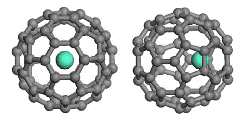Department of Chemistry
Document Type
Article
Date of this Version
5-27-2005
Abstract
High-level ab initio calculations have been carried out to reexamine relative stability of bowl, cage, and ring isomers of C20 and C20-. The total electronic energies of the three isomers show different energy orderings, strongly depending on the hybrid functionals selected. It is found that among three popular hybrid density-functional (DF) methods B3LYP, B3PW91, PBE1PBE, and a new hybrid-meta-DF method TPSSKCIS, only the PBE1PBE method (with cc-pVTZ basis set) gives qualitatively correct energy ordering as that predicted from ab initio CCSD(T)/cc-pVDZ [CCSD(T)—coupled-cluster method including singles, doubles, and noniterative perturbative triples; cc-pVDZ—correlation consistent polarized valence double zeta] as well as from MP4(SDQ)/cc-pVTZ [MP4—fourth-order Moller–Plesset; cc-pVTZ—correlation consistent polarized valence triple zeta] calculations. Both CCSD(T) and MP4 calculations indicate that the bowl is most likely the global minimum of neutral C20 isomers, followed by the fullerene cage and ring. For the anionic counterparts, the PBE1PBE calculation also agrees with MP4/cc-pVTZ calculation, both predicting that the bowl is still the lowest-energy structure of C20- at T=0 K, followed by the ring and the cage. In contrast, both B3LYP/cc-pVTZ and B3PW91/cc-pVTZ calculations predict that the ring is the lowest-energy structure of C20- . Apparently, this good reliability in predicting the energy ordering renders the hybrid PBE method a leading choice for predicting relative stability among large-sized carbon clusters and other carbon nanostructures se.g., finite-size carbon nanotubes, nano-onions, or nanohornsd. The relative stabilities derived from total energy with Gibbs free-energy corrections demonstrate a changing ordering in which ring becomes more favorable for both C20 and C20- at high temperatures. Finally, photoelectron spectra (PES) for the anionic C20- isomers have been computed. With binding energies up to 7 eV, the simulated PES show ample spectral features to distinguish the three competitive C20- isomers.



Comments
Published by American Institute of Physics. J. Chem. Physics 122, 204109 (2005). ©2005 American Institute of Physics. Permission to use. http://jcp.aip.org/.